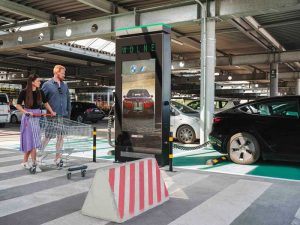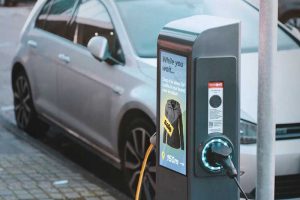
Adding a digital display that can play video, ads, and other visual content can help a network stand out and drive incremental revenue.
The future of charging station advertising
Just as EV adoption rates are starting to climb and networks are beginning to proliferate, advertisers are seeking out new ways to engage with consumers in a more meaningful way. Personalized, contextually relevant content is one way to achieve this, especially amidst all the clutter seen on digital channels today and the demise of the third-party cookie. In this climate, more brands are looking to advertising channels such as DOOH to reach their audience with outstanding creative and messaging.
Within the DOOH landscape, advertisers are attracted to EV charging stations for their unique appeal. Equipped with full-screen digital displays, they provide a non-traditional approach to reaching audiences in the locations they frequent most, be it shopping centres, restaurants, entertainment complexes, or other venues. However, it is not just the location of the EV chargers that presents new opportunities. According to a recent survey, EV owners tend to have more disposable income, making them a highly desirable demographic for advertisers. Further, consumers at large have become “greener” in their purchasing decisions, with more than 50 per cent of the general population saying they would be more interested in doing business with a company that is committed to sustainability efforts.6,7

Depending on the software setup of the EV charger display, an advertiser could surface relevant content based on the amount of charge time required for a specific vehicle.
EV charging stations outfitted with ad displays continue to pop up around the world, making it difficult for advertisers to ignore their promise. Since EV screens are almost always positioned at eye level in locations with high vehicle or foot traffic, they are not only able to easily capture the interest of carbon-conscious EV owners, but also the attention of passersby. Advertisers can even take their engagement one step further by integrating interactive content, QR codes, or hashtags into EV charger display ads, to drive both audiences online. However, EV charger owners and advertisers have not even begun to scratch the surface of what is possible. As more brands and local businesses experiment with the channel, they are uncovering a host of advantages to the place-based strategies it offers.
The point-of-purchase advantage
Modern marketers—and consumer packaged goods (CPG) brands in particular—want to pursue customers closer to the point of purchase, and EV charging stations equipped with ad displays provide a solution. Located near retail centres and other essential business outfits, these chargers open the doors for brands to engage with consumers shortly before making purchase decisions. This is crucial, considering two-thirds of shoppers have reported noticing out-of-home (OOH) ads while enroute to retailers, and when they are located very close to or right outside a store.8
Further, a survey revealed most climate-conscious consumers would spend more time shopping at retail and grocery stores if waiting for a vehicle to charge.9 Depending on the software setup of the EV charger display, an advertiser could surface relevant content based on the amount of charge time required for a specific vehicle. For example, an ad might propose a driver spends time at a nearby cafe when the average charge is estimated to take 30 minutes or longer.10





